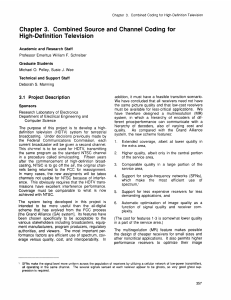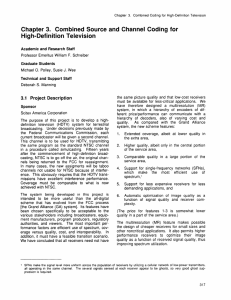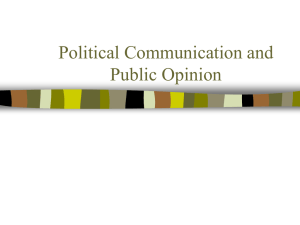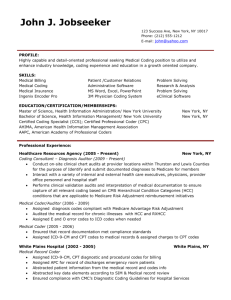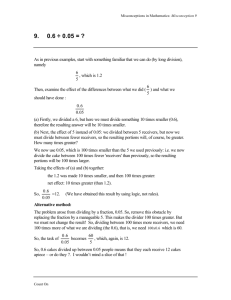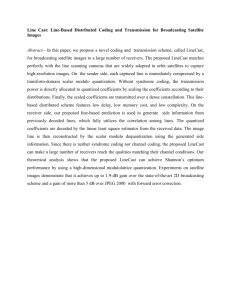Chapter 3. Combined Source and ... High-Definition Television 3.1 Project Description
advertisement
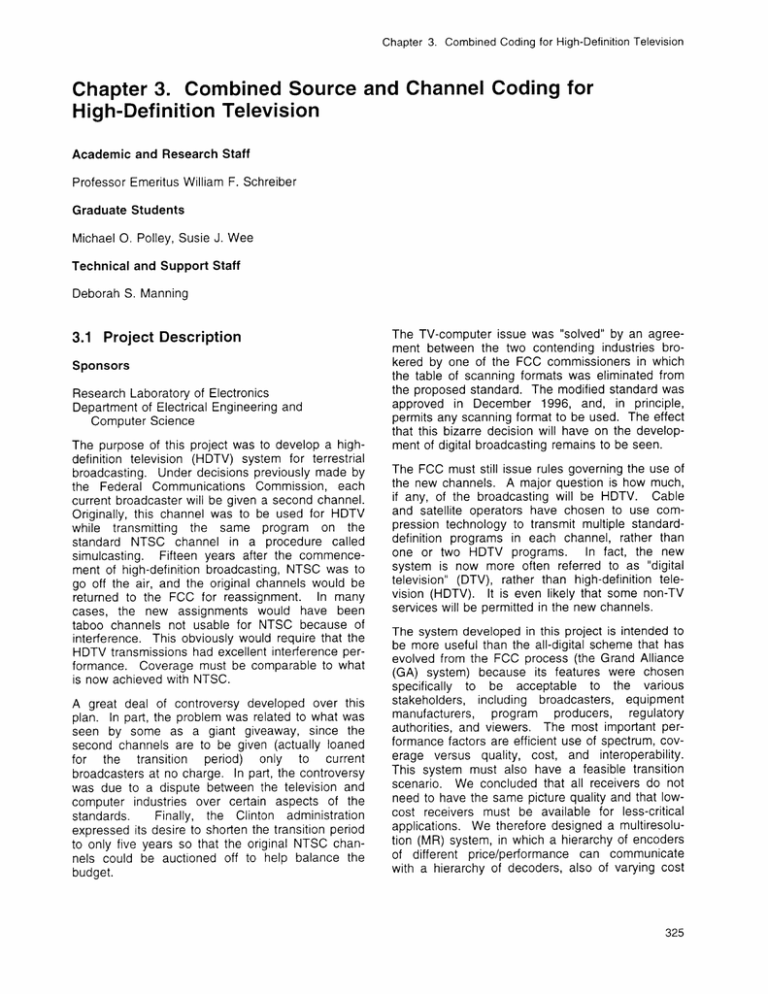
Chapter 3. Combined Coding for High-Definition Television Chapter 3. Combined Source and Channel Coding for High-Definition Television Academic and Research Staff Professor Emeritus William F. Schreiber Graduate Students Michael O. Polley, Susie J. Wee Technical and Support Staff Deborah S. Manning 3.1 Project Description Sponsors Research Laboratory of Electronics Department of Electrical Engineering and Computer Science The purpose of this project was to develop a highdefinition television (HDTV) system for terrestrial broadcasting. Under decisions previously made by the Federal Communications Commission, each current broadcaster will be given a second channel. Originally, this channel was to be used for HDTV while transmitting the same program on the standard NTSC channel in a procedure called simulcasting. Fifteen years after the commencement of high-definition broadcasting, NTSC was to go off the air, and the original channels would be returned to the FCC for reassignment. In many cases, the new assignments would have been taboo channels not usable for NTSC because of interference. This obviously would require that the HDTV transmissions had excellent interference performance. Coverage must be comparable to what is now achieved with NTSC. A great deal of controversy developed over this plan. In part, the problem was related to what was seen by some as a giant giveaway, since the second channels are to be given (actually loaned for the transition period) only to current broadcasters at no charge. In part, the controversy was due to a dispute between the television and computer industries over certain aspects of the Finally, the Clinton administration standards. expressed its desire to shorten the transition period to only five years so that the original NTSC channels could be auctioned off to help balance the budget. The TV-computer issue was "solved" by an agreement between the two contending industries brokered by one of the FCC commissioners in which the table of scanning formats was eliminated from the proposed standard. The modified standard was approved in December 1996, and, in principle, permits any scanning format to be used. The effect that this bizarre decision will have on the development of digital broadcasting remains to be seen. The FCC must still issue rules governing the use of the new channels. A major question is how much, if any, of the broadcasting will be HDTV. Cable and satellite operators have chosen to use compression technology to transmit multiple standarddefinition programs in each channel, rather than In fact, the new one or two HDTV programs. system is now more often referred to as "digital television" (DTV), rather than high-definition television (HDTV). It is even likely that some non-TV services will be permitted in the new channels. The system developed in this project is intended to be more useful than the all-digital scheme that has evolved from the FCC process (the Grand Alliance (GA) system) because its features were chosen specifically to be acceptable to the various stakeholders, including broadcasters, equipment manufacturers, program producers, regulatory authorities, and viewers. The most important performance factors are efficient use of spectrum, coverage versus quality, cost, and interoperability. This system must also have a feasible transition scenario. We concluded that all receivers do not need to have the same picture quality and that lowcost receivers must be available for less-critical applications. We therefore designed a multiresolution (MR) system, in which a hierarchy of encoders of different price/performance can communicate with a hierarchy of decoders, also of varying cost 325 Chapter 3. Combined Coding for High-Definition Television and quality. As compared with the Grand Alliance system, the new scheme features: 1. Extended coverage, albeit at lower quality in the extra area, 2. Higher quality, albeit only in the central portion of the service area, 3. Comparable quality in a large portion of the service area. The price for these features is somewhat lower quality in a part of the service area. 4. Support for single-frequency networks, which make the most efficient use of spectrum,1 5. Support for less expensive receivers for less demanding applications, Automatic optimization of image quality as a function of signal quality and receiver complexity. 6. The multiresolution (MR) feature makes possible the design of cheaper receivers for small sizes and It also permits other noncritical applications. higher-performance receivers to optimize their image quality as a function of received signal quality, thus improving spectrum utilization. The MR feature is achieved by use of combined source and channel coding employing a pyramid technique. The coded video and audio data is divided into a number (typically three or four) of data streams. The quality of the reconstructed video depends on the number of streams recovered and their signal-to-noise ratio. Thus the lowest stream provides a picture somewhat better than studio-quality NTSC to the least-expensive receivers and/or under poor reception conditions. The higher streams are used to enhance the image quality. The streams are packaged by the channel coder so that the number recovered depends on the signal strength and receiver performance. The lowest quality level features standard MPEG-2 coding so that the cheapest receivers can use 2 single-chip MPEG decoders. 3.2 Technology In the GA system, digital source coding is used to get very high compression, which is needed, in part, because all-digital channel coding does not make best use of the analog channel capacity. Our system uses multiresolution hybrid analog/digital coding, which permits both high compression and efficient use of spectrum. The source coder uses some MPEG features, but produces data in a form suitable for hybrid channel coding. This data is not all of one kind; some requires essentially perfect transmission and some can tolerate a certain amount of noise and distortion. The channel coder uses spread spectrum and 3 orthogonal frequency-division multiplex (OFDM), which, in combination, give good resistance to analog channel impairments and facilitate multiresolution operation. It transmits more sensitive data digitally and less sensitive data in analog form. The received signal "looks" simple to a low-performance receiver, while a high-performance receiver, with its more powerful decoder, "knows" where to look in the signal for the higher streams of data. These are recoverable at locations where the signal strength is higher and/or where the antenna and receiver are of better quality. Digital performance is enhanced by extensive forward error correction. The simpler receivers are expected to be substantially cheaper than those used in the GA system, while the higher-performance receivers will be of comparable complexity and cost. SFNs make the signal level more uniform across the population of receivers by utilizing a cellular network of low-power transmitters, all operating in the same channel. Several signals sensed at each receiver appear to be ghosts, so very good ghost suppression is required. The Motion Picture Experts Group has promulgated an international all-digital standard for TV source coding, which has been adopted by many groups. Inexpensive coder and decoder chips are becoming available, which makes the use of MPEG coding very attractive. OFDM was invented in the U.S., but in recent years has been developed in Europe for digital audio broadcasting. It is also intended for use in digital TV terrestrial broadcasting in Europe. The coded form is referred to as COFDM. The Japanese announced in 1996 that their forthcoming digital broadcasting system would also use COFDM. COFDM was briefly examined in the FCC inquiry and rejected as not ready for practical use. 326 RLE Progress Report Number 139 Chapter 3. Combined Coding for High-Definition Television 3.3 Final Status By the end of 1995, the system simulation was Output sequences could be nearly completed. demonstrated after transmission through a simulated terrestrial channel showing the effect of noise and echoes on the digital and analog components Three levels of resolution were of the signal. For attained at three different receiver CNRs. details, see the 1995 RLE Progress Report. A small amount of work remained to be done on the source coder. The channel coder work was complete by January 1996. It fulfills all the expectations for the system that were held at the beginning of the project. One of the most important of these is the performance in the presence of echoes. In contrast to the performance of conventional systems such as the Grand Alliance system, the performance of the new system actually improves with large echoes. The echo performance of this system makes it suitable for use in single-frequency networks (SFNs) without the use of directional antennas. In these systems, the conventional centralized transmitter is replaced by a cellular network of low-power transmitters, all emitting the same signal. Receivers, particularly with omnidirectional antennas, see a number of very strong "echoes." The channel coder that we have developed is the first, in my opinion, that is both practical in terms of computation and has good enough performance to be used in this way. SFNs permit much more efficient use of spectrum that conventional terrestrial broadcast systems because they effectively eliminate the effect of co-channel interference. The service area of each station is delimited by the location of the cellular transmitters, and it is only in a narrow region around the edge of the service area that two stations must compete for the same receivers. The source coder work was finished in May 1996. Like the channel coder, the performance achieved met all the expectations at the beginning of the project. Some work was done on dealing with the image degradation produced by the use of MPEG-2 for the base-level signal. Although the base-level images look quite good at normal frame rate, individual frames have errors that are automatically eliminated at the higher levels. While this improves the higher-level image quality, it uses up a substantial proportion of the channel capacity that might be used, instead, to increase the resolution. It was not possible to devote enough time to this issue in the course of the project. 3.4 The Future The December 1996 FCC decision, if not overturned, means that the United States will not use either COFDM or hybrid transmission. However, at long last, some attention is being given to the effect of the cost of the first receivers on the speed of the transition from NTSC to digital broadcasting, especially now that a very short transition period before the shut-down of NTSC is being discussed. The likelihood that the initial broadcasting will be almost entirely standard definition has also reopened the subject of "nondisruptive improvement over time," a long-standing FCC desideratum for the new system. As a result, the Advanced Television Systems Committee (ATSC), which is the official body for documenting DTV and HDTV standards, is reconsidering the use of multiresolution systems (now often called layered systems) such as the one developed for this project. Both the source-coding scheme and the nonuniform constellations of the channel-coding scheme that have been developed may have some relevance to the proposals of the ATSC. 3.5 Publications Schreiber, W.F. An Advanced Multiresolution Television System. RLE Technical Report 601. Cambridge, Massachusetts: MIT Research Laboratory of Electronics, January 1997. Schreiber, W.F., M.O. Polley, and S.J.Wee. "Digital Nondisruptive Broadcasting: Television J SSMPTE. ForthImprovement over Time." coming. 327 328 RLE Progress Report Number 139
